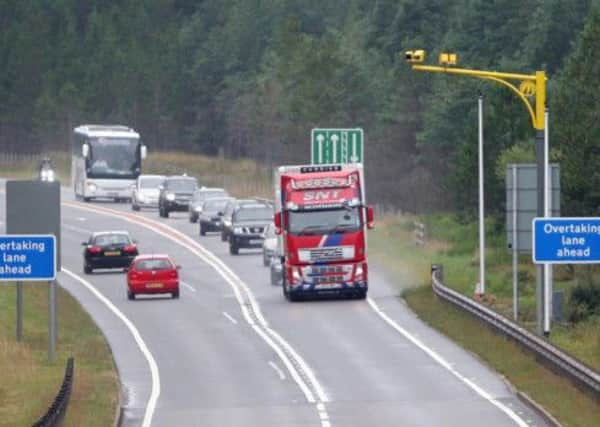Cameras cut A9 speeding by 90 per cent


Transport chiefs claim they have been vindicated in the decision to introduce the cameras in a bid to cut deaths on the road – dubbed the most dangerous in Scotland.
A total of 298 vehicles were caught exceeding the speed limit since they came into operation on 28 October last year, compared to 2,493 in the same period of 2013.
Advertisement
Hide AdAdvertisement
Hide AdThe figures also revealed the number of drivers traced travelling at more than 10mph above the limit had fallen 97 per cent.
The findings, published by the A9 Safety Group, which includes government agency Transport Scotland, said overall speeding was down from around one in three drivers to one in 20.
There has been no fatalities on the sections where the cameras are in operation.
The £3 million system comprises 100 cameras on 80 miles of single carriageway sections between Inverness and Dunblane. A pilot project was also launched permitting HGVs to drive at 50mph rather than 40mph.
FOLLOW US
-----------------------------------------
-----------------------------------------
SCOTSMAN TABLET AND MOBILE APPS
Transport Scotland’s Stewart Leggett, chairman of the A9 Safety Group, said: “Drivers are clearly paying heed and moderating their speed.
“All the early findings on speed, journey time and journey time reliability are in line with our predictions, while traffic volumes on the A9 are remaining higher than in 2013, with no evidence of drivers diverting on to other routes.
“The low number of drivers being detected by the cameras and the speed profiles from along the route indicate the early effectiveness of the cameras in improving behaviour.”
The figures have been welcomed by politicians, Police Scotland, Road Safety Scotland and the Road Haulage Association.Chief Superintendent Iain Murray, head of road policing, said: “This is an encouraging start. In the first three months of operation we have seen a more than eight-fold decrease in the number of people caught speeding. It is clear that the cameras are changing driver behaviour.”
Advertisement
Hide AdAdvertisement
Hide AdMartin Reid of the Road Haulage Association said the majority of their members had noticed improvements since the speed limits for HGVs was increased.
He added: “Almost universally our members report that the flow of traffic is much improved and that journey times if anything can be slightly shorter.”
David Stewart, the Shadow Transport Minister, said: “This massive decrease in the number of motorists speeding on the A9 is clearly welcome news.
“The trial increase in HGV speed looks as if it has helped to reduce journey times and more importantly has reduced driver frustration for those travelling behind lorries, which could often lead to dangerous overtaking.”
Anti-camera campaigner Mike Burns, of the group A9 Average Speed Cameras are Not the Answer, said: “Opinion varies on what the effect is.
“You now have vehicles travelling in convoy on a single carriageway, but when people move on to a dual carriageway, as one driver described it, it’s like champagne corks popping out of bottles because people are putting their foot down to get past the queue s because they’re frustrated.
“The cameras don’t solve the problem of the A9.”